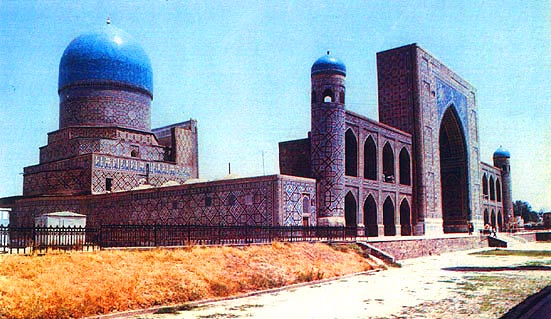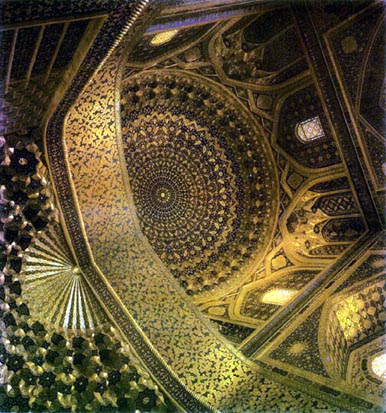A caravanserai was pulled down on the north side
of the square to make way for Its biggest, newest, most extravagant building,
the Tilla Kari madrasa (built 1646-59). Its 120 m-long facade is unusual
in incorporating the outward-facing arched balconies of
students' cells. What sets it apart, though, is the mosque
on the west side of the courtyard. ' Tilla Kari ' means 'gilded', and though
there is gilding on the madrasa's facade, it Is nothing compared with the
1000 sq m of gold leaf used in the restoration of the 'Golden Mosque' In
1979. It left Geoffrey Moorhouse open-mouthed:
'Here was a richness of colour greater than I had ever
seen anywhere before, a splendour of red beyond the opulence of rubies
and a royal blue of such intensity that it would have hurt the eyes If
it had been unrelieved. It was made perfect not only by the alliance with
red, but by flashes of orange and dull gleanings of gold which punctuated
it...'
 The Soviet view was that the use of gold was decadent, a
lazy way of surpassing the splendour achieved by superior craftsmanship
In the Ulug Bek madrasa. But the craftsmanship in the Golden Mosque Is
not bad. Beneath the huge turquoise dome, for example, the celling appears
domed; actually it is flat, and the trompe l'oeil effect is achieved by
an extraordinarily intricate pattern of plant stems in gold leaf, which
get smaller and smaller towards the centre.
The mosque was built along with the madrasa but was always
a separate institution, built to succeed Blbi Khanym-which had already
collapsed-as the city's main place of worship. Women were allowed in on
Fridays. Now, just 14 years after being restored, all its decoration Is
threatened by rising groundwater resulting from cotton irrigation. The
papier mach6 onto which much of the red and blue Is painted is going soggy
and peeling off, and restoration funds no longer flow from a Moscow which
is now part of a foreign country and is anyway destitute.
The Soviet view was that the use of gold was decadent, a
lazy way of surpassing the splendour achieved by superior craftsmanship
In the Ulug Bek madrasa. But the craftsmanship in the Golden Mosque Is
not bad. Beneath the huge turquoise dome, for example, the celling appears
domed; actually it is flat, and the trompe l'oeil effect is achieved by
an extraordinarily intricate pattern of plant stems in gold leaf, which
get smaller and smaller towards the centre.
The mosque was built along with the madrasa but was always
a separate institution, built to succeed Blbi Khanym-which had already
collapsed-as the city's main place of worship. Women were allowed in on
Fridays. Now, just 14 years after being restored, all its decoration Is
threatened by rising groundwater resulting from cotton irrigation. The
papier mach6 onto which much of the red and blue Is painted is going soggy
and peeling off, and restoration funds no longer flow from a Moscow which
is now part of a foreign country and is anyway destitute.
 For now, the substance of what Curzon called 'the noblest
public square In the world' remains intact, and it may still be true that
'no European spectacle indeed can adequately be compared with It, in our
inability to point to an open space in any western city that is commanded
on three of its four sides by Gothic cathedrals of the finest order.'
For now, the substance of what Curzon called 'the noblest
public square In the world' remains intact, and it may still be true that
'no European spectacle indeed can adequately be compared with It, in our
inability to point to an open space in any western city that is commanded
on three of its four sides by Gothic cathedrals of the finest order.'
[back]
|
